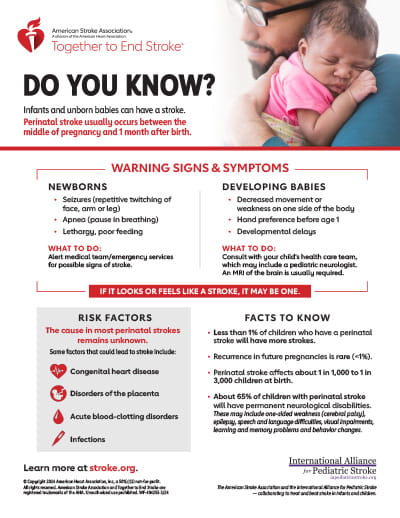Perinatal Stroke Infographic
 American Stroke Association
American Stroke Association
Together to End Stroke®
Do you know?
Infants and unborn babies can have a stroke.
Perinatal stroke usually occurs between the middle of pregnancy and 1 month after birth.
Warning Signs and Symptoms
Newborns
- Seizures (repetitive twitching of face, arm or leg)
- Apnea (pause in breathing)
- Lethargy, poor feeding
What to do: Alert medical team/emergency services for possible signs of stroke.
Developing Babies
- Decreased movement or weakness on one side of the body
- Hand preference before age 1
- Developmental delays
What to do: Consult with your child’s health care team, which may include a pediatric neurologist. An MRI of the brain is usually required.
If it looks or feels like a stroke, it maybe one.
Risk Factors
The cause in most perinatal strokes remains unknown.
Some factors that could lead to stroke include:
- Congenital heart disease
- Disorders of the placenta
- Acute blood-clotting disorders
- Infections
Facts to Know
- Less than 1% of children who have a perinatal stroke will have more strokes.
- Recurrence in future pregnancies is rare (<1%).
- Perinatal stroke affects about 1 in 1,000 to 1 in 3,000 children at birth.
- About 65% of children with perinatal stroke will have permanent neurological disabilities. These may include one-sided weakness (cerebral palsy), epilepsy, speech and language difficulties, visual impairments, learning and memory problems and behavior changes.
International Alliance for Pediatric Stroke
The American Stroke Association and the International Alliance for Pediatric Stroke — collaborating to treat and beat stroke in infants and children.
© Copyright 2024 American Heart Association, Inc, a 501(c)(3) not-for-profit. All rights reserved. American Stroke Association and Together to End Stroke are registered trademarks of the AHA. Unauthorized use prohibited. WF-464295 3/24